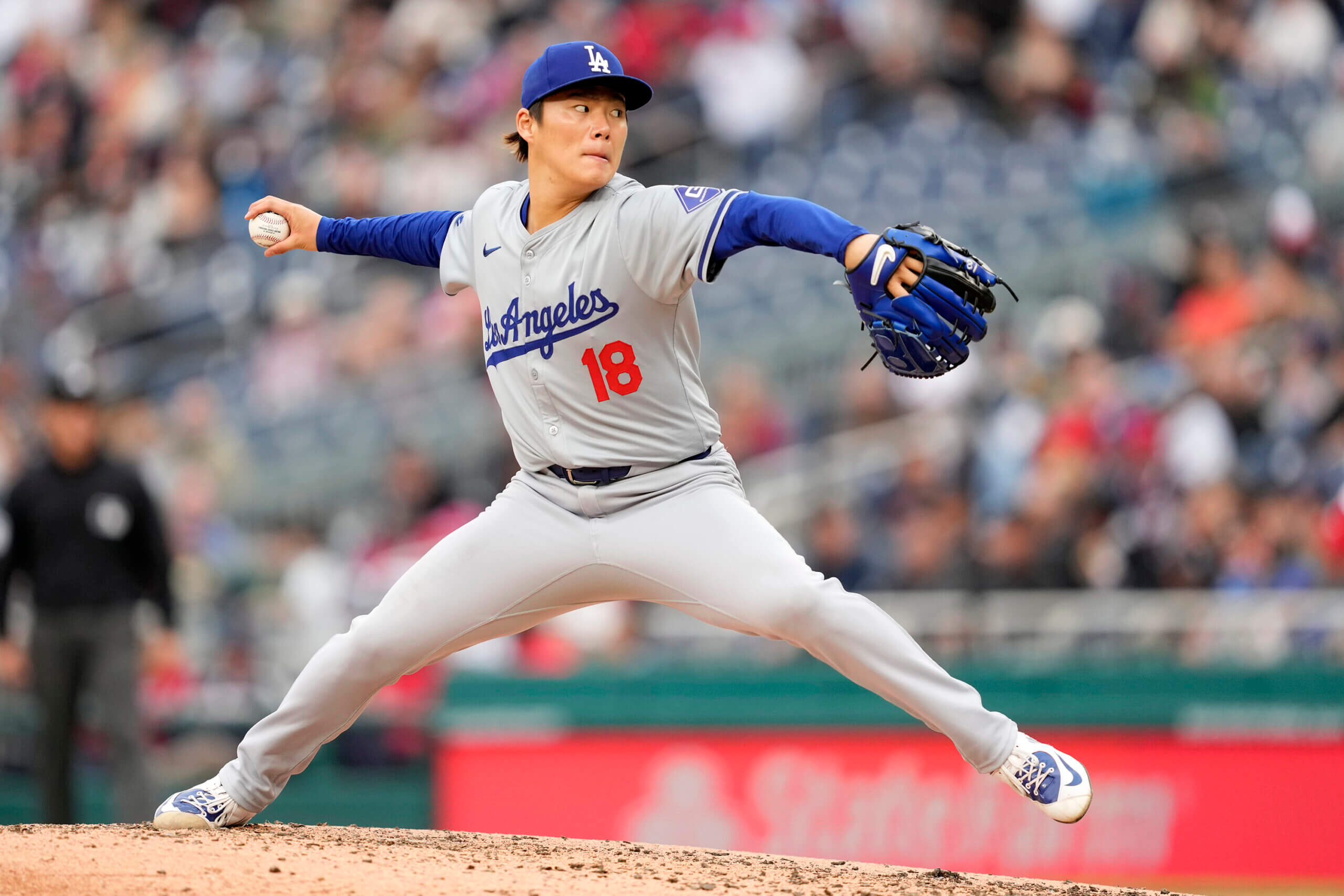
WASHINGTON — Disaster was coming straight for Yoshinobu Yamamoto’s head, and he caught it. The hardest-hit ball the Los Angeles Dodgers right-hander gave up all day – a 104.8 mph liner on a splitter walloped by Washington Nationals outfielder Eddie Rosario — was coming right at his dome, with barely enough time to throw up his glove.
“It was like a gunshot,” said catcher Austin Barnes, who had a front-row seat from behind the plate. “It was scary.”
Luckily for Yamamoto, the ball went right into the glove. With the club’s $325 million investment no longer in peril, all he could do was laugh when staff and trainers rushed out to check on him.
What was said, Yamamoto said through interpreter Yoshihiro Sonoda, “we can’t share.”
His manager was more forthcoming.
“He said he almost died,” Dave Roberts said. “So that was pretty funny.”
Yamamoto with the quick reaction. 🫣 pic.twitter.com/AJhvK3jKsv
— SportsNet LA (@SportsNetLA) April 25, 2024
After the scare, Yamamoto fired a first-pitch fastball that nipped the outside corner and proceeded to strike out the next two batters, continuing his best start to date.
Turns out, Yamamoto proved quite effective at avoiding serious damage on Thursday as part of a 2-1 win. That represents progress. The 25-year-old has flashed his tantalizing promise in his first month in Major League Baseball. He’s also demonstrated the learning curve that exists even for a pitcher who dominated the best hitters in Japan for each of the past three years.
Through five starts, his fastball got crushed. Opposing batters put up Shohei Ohtani-like numbers (.355 batting average, .710 slugging percentage) against his four-seamer. It takes just a cursory look at a heat map to understand why. Yamamoto’s heater kept “leaking” over the plate when he’d try to attack away to right-handed hitters and inside to left-handed hitters, leaving center-cut offerings that opponents battered.
“His best bullets will kind of stick,” assistant pitching coach Connor McGuiness said this week. “Some of the other ones he just doesn’t clip them nearly as well … any little mistake he’s getting punished right now.”
The hypotheses vary. McGuiness noted that Yamamoto went through an acclimation period with the different baseball this spring, though that hasn’t seemed to impact the rest of his arsenal. The Dodgers implemented their changes with Yamamoto in a “slow drip,” McGuiness said, largely allowing Yamamoto to pound the lower part of the zone with his four-seamer much like he did in his dominant run in Japan but encouraging him to take more elevated chances to change eye levels.
He has not thrown his sinker once this season, according to Statcast’s tracking (though McGuiness said Yamamoto has thrown it “a couple times”). They’ve largely mothballed the pitch, which has a similar shape to his straight fastball but more run, in hopes of living on the corners more frequently.
His delivery has shapeshifted multiple times this spring, and his fastball command has had to play catch-up as a result. Thursday proved to be the best Yamamoto said he’s felt about consistently executing his mechanics all season, and his fastball benefitted.
He also has not afforded himself much leash. As the Dodgers have tweaked the dials on his usage and sequencing, opposing hitters have jumped on fastballs in predictable counts that they know will be over the plate. They’ve already had him throw his fastball just 37 percent of the time to mitigate the damage.
The Dodgers have urged patience. But the early, alarming numbers raised an intriguing question about the industry’s evaluation of Yamamoto: Does his fastball play at this level?
Thursday provided a resounding answer. His overall usage remained relatively similar, but he found himself using his other offerings early in counts to steal strikes. The fastballs Yamamoto threw did not invite as much danger. The Nationals recorded just one hit in seven at-bats that ended on the pitch.
“This was probably the best I’ve seen him,” Barnes said. “Just putting the fastball where he wants. I thought he was really good with the heater, both sides of the plate and just really drilling it. It didn’t have any leak over and then just mixing.
“I thought his fastball was his most important pitch. I thought he located it well and (was) driving it through me. He had the hitters kind of in-between timing. You can’t really sit soft because you have to respect the fastball.”
The result was Yamamoto’s finest start in the big leagues to date. He completed six innings without allowing a run. The rest of his offerings thrived.
“My off-speed pitches, I was able to throw for strikes,” Yamamoto said. “So as a result my fastball was able to be used more effectively.”
Until Rosario’s line drive back up the box led off the fifth inning, there was no threat of harm.
The Dodgers will take it. In the 27 innings since Yamamoto’s big-league debut blew up in one inning in Seoul, South Korea, he’s had an ERA of 2.00. He’s shown he can miss bats and avoid walks. And on days like Thursday when he can avoid having his fastball serve as a launching point, he can be dominant. It’s difficult to separate the player from the massive contract, but Yamamoto has held his own.
So long as he keeps his head on a swivel.
(Photo of Yoshinobu Yamamoto: Mitchell Layton / Getty Images)

